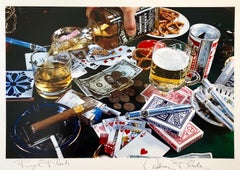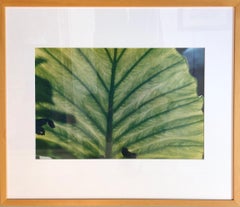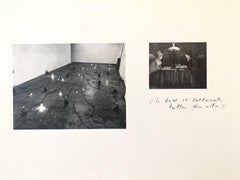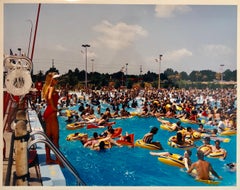Lions Gallery Photography
to
607
7
306
278
20
277
167
80
24
59
Overall Height
to
Overall Width
to
197
102
21
19
11
9
2
203
105
72
68
62
49
48
42
36
35
32
32
26
20
19
19
19
18
17
17
3
520
83
1
4
12
10
41
70
121
140
52
31
24
22
20
229
217
186
167
23
Pop Art Vintage Photograph Dye Transfer Print "Leonardo's Lady" Audrey Flack
By Audrey Flack
Located in Surfside, FL
Hand signed and titled in ink by the artist from edition of 50 (plus proofs). Color Photo printed at CVI Lab by master printer Guy Stricherz. Published by Prestige Art Ltd. From the color saturated 1980's. A portrait by Leonardo da Vinci, nail polish, a pink rose, pocket watch, green pear. "Leonardo's Lady" a still life tableaux.
Audrey L. Flack (born May 30, 1931 in New York City, New York) is an American artist. Her work pioneered the art genre of photorealism; her work encompasses painting, sculpture, and photography. From Audrey Flack: 12 Photographs 1973 to 1983. A set of this portfolio is in the collections of the Harvard Art Museums. The Kodakchrome photos were photgraphed with a NIkon camera, the Ektachrome photographs were taken with a Hasselblad camera. Each negative was printed on a 20 X24 inche fiber based paper, dry mounted wth seal MT5 dry mounting tissue to 4 ply 100% cotton fiber board by Arnon Ben-David and Ari Rivera Gonzales under the supervision of Carol Brower.
Flack has numerous academic degrees, including both a graduate and an honorary doctorate degree from Cooper Union in New York City. Additionally she has a bachelor's degree in Fine Arts from Yale University and attended New York University Institute of Fine Arts where she studied art history. In May 2015, Flack received an honorary Doctor of Fine Arts degree from Clark University, where she also gave a commencement address.
Flack's work is displayed in several major museums, including the Museum of Modern Art, the Metropolitan Museum of Art, the Whitney Museum of American Art, and the Solomon R. Guggenheim Museum. Flack's photorealist paintings were the first such paintings to be purchased for the Museum of Modern Art’s permanent collection, and her legacy as a photorealist lives on to influence many American and International artists today. J. B. Speed Art Museum in Louisville, Kentucky, organized a retrospective of her work, and Flack’s pioneering efforts into the world of photorealism popularized the genre to the extent that it remains today.
Flack attended New York's High School of Music & Art. She studied fine arts in New York from 1948 to 1953, studying under Josef Albers among others. She earned a graduate degree and received an honorary doctorate from Cooper Union in New York City, and a Bachelor of Fine Arts from Yale University. She studied art history at the Institute of Fine Arts, New York University.
1953 New York University Institute of Fine Arts, New York City
1952 BFA, Yale University, New Haven, Connecticut
1948-51 Cooper Union, New York City
Career
Flack's early work in the 1950s was abstract expressionist; one such painting paid tribute to Franz Kline. Most influential amongst her early supporters was the Bauhaus artist Josef Albers. It was he who persuaded Flack to take up a scholarship at Yale with the mission of shaking up the institution's stuffy academic reputation. The ironic kitsch themes in her early work influenced Jeff Koons. But gradually, Flack became a New Realist and then evolved into photorealism during the 1960s. Her move to the photorealist style was in part because she wanted her art to communicate to the viewer. She was the first photorealist painter to be added to the collection of the Museum of Modern Art in 1966. Between 1976 and 1978 she painted her Vanitas series, including the piece Marilyn.
The critic Graham Thompson wrote, "One demonstration of the way photography became assimilated into the art world is the success of photorealist painting in the late 1960s and early 1970s. It is also called super-realism, radical realism, or hyper-realism and painters like Richard Estes, Chuck Close, and Audrey Flack as well, often worked from photographic stills to create paintings that appeared to be photographs."
In the early 1980s Flack's artistic medium shifted from painting to sculpture. She describes this shift as a desire for "something solid, real, tangible. Something to hold and to hold on to." Flack discusses the fact that she is self-taught in sculpture. She incorporates religion and mythology into her sculpture rather than the historical or everyday subjects of her paintings. Her sculptures often demonstrate a connection to the female form, including a series of diverse, heroic women and goddess figures. These depictions of women differ from those of traditional femininity, but rather are athletic, older, and strong. As Flack describes them: "they are real yet idealized... the 'goddesses in everywoman.'"
Flack has claimed to have found the photorealist movement too restricting, and now gains much of her inspiration from Baroque art.
Flack is currently represented by the Louis K. Meisel Gallery and Hollis Taggart Galleries. Her work is held in the collections of museums around the world, including the Metropolitan Museum of Art, The Museum of Modern Art, the Solomon R. Guggenheim Museum, the Whitney Museum of American Art, the Allen Memorial Art Museum, and the National Gallery of Australia in Canberra, Australia.
She was awarded the St. Gaudens Medal from Cooper Union, and the honorary Albert Dome professorship from Bridgeport University. She is an honorary professor at George Washington University, is currently a visiting professor at the University of Pennsylvania and has taught and lectured extensively both nationally, and internationally.
Flack lives and works in New York City and Long Island.
Audrey Flack is best known for her photo-realist paintings and was one of the first artists to use photographs as the basis for painting. The genre, taking its cues from Pop Art, incorporates depictions of the real and the regular, from advertisements to cars to cosmetics. Flack's work brings in everyday household items like tubes of lipstick, perfume bottles, Hispanic Madonnas, and fruit. These inanimate objects often disturb or crowd the pictorial space, which are often composed as table-top still lives. Flack often brings in actual accounts of history into her photorealist paintings, such as World War II' (Vanitas) and Kennedy Motorcade. Women were frequently the subject of her photo realist paintings. In her Neoclassical public sculpture of gilded bronze...
Category
1980s Photorealist Color Photography
Materials
Photographic Paper, C Print, Dye Transfer
Pop Art Vintage Color Photograph Dye Transfer Print "Royal Flush" Audrey Flack
By Audrey Flack
Located in Surfside, FL
Hand signed and titled in ink by the artist from edition of 50 (plus proofs). Color Photo printed at CVI Lab by master printer Guy Stricherz. Published by Prestige Art Ltd. From the color saturated 1980's. Royal Flush, cigars, Jack Daniels Whiskey, cash, playing cards and beer. Boys night out. perfect for the man cave or bachelor pad.
Audrey L. Flack (born May 30, 1931 in New York City, New York) is an American artist. Her work pioneered the art genre of photorealism; her work encompasses painting, sculpture, and photography. From Audrey Flack: 12 Photographs 1973 to 1983. A set of this portfolio is in the collections of the Harvard Art Museums. The Kodakchrome photos were photgraphed with a NIkon camera, the Ektachrome photographs were taken with a Hasselblad camera. Each negative was printed on a 20 X24 inche fiber based paper, dry mounted wth seal MT5 dry mounting tissue to 4 ply 100% cotton fiber board by Arnon Ben-David and Ari Rivera Gonzales under the supervision of Carol Brower.
Flack has numerous academic degrees, including both a graduate and an honorary doctorate degree from Cooper Union in New York City. Additionally she has a bachelor's degree in Fine Arts from Yale University and attended New York University Institute of Fine Arts where she studied art history. In May 2015, Flack received an honorary Doctor of Fine Arts degree from Clark University, where she also gave a commencement address.
Flack's work is displayed in several major museums, including the Museum of Modern Art, the Metropolitan Museum of Art, the Whitney Museum of American Art, and the Solomon R. Guggenheim Museum. Flack's photorealist paintings were the first such paintings to be purchased for the Museum of Modern Art’s permanent collection, and her legacy as a photorealist lives on to influence many American and International artists today. J. B. Speed Art Museum in Louisville, Kentucky, organized a retrospective of her work, and Flack’s pioneering efforts into the world of photorealism popularized the genre to the extent that it remains today.
Flack attended New York's High School of Music & Art. She studied fine arts in New York from 1948 to 1953, studying under Josef Albers among others. She earned a graduate degree and received an honorary doctorate from Cooper Union in New York City, and a Bachelor of Fine Arts from Yale University. She studied art history at the Institute of Fine Arts, New York University.
1953 New York University Institute of Fine Arts, New York City
1952 BFA, Yale University, New Haven, Connecticut
1948-51 Cooper Union, New York City
Career
Flack's early work in the 1950s was abstract expressionist; one such painting paid tribute to Franz Kline. Most influential amongst her early supporters was the Bauhaus artist Josef Albers. It was he who persuaded Flack to take up a scholarship at Yale with the mission of shaking up the institution's stuffy academic reputation. The ironic kitsch themes in her early work influenced Jeff Koons. But gradually, Flack became a New Realist and then evolved into photorealism during the 1960s. Her move to the photorealist style was in part because she wanted her art to communicate to the viewer. She was the first photorealist painter to be added to the collection of the Museum of Modern Art in 1966. Between 1976 and 1978 she painted her Vanitas series, including the piece Marilyn.
The critic Graham Thompson wrote, "One demonstration of the way photography became assimilated into the art world is the success of photorealist painting in the late 1960s and early 1970s. It is also called super-realism, radical realism, or hyper-realism and painters like Richard Estes, Chuck Close, and Audrey Flack as well, often worked from photographic stills to create paintings that appeared to be photographs."
In the early 1980s Flack's artistic medium shifted from painting to sculpture. She describes this shift as a desire for "something solid, real, tangible. Something to hold and to hold on to." Flack discusses the fact that she is self-taught in sculpture. She incorporates religion and mythology into her sculpture rather than the historical or everyday subjects of her paintings. Her sculptures often demonstrate a connection to the female form, including a series of diverse, heroic women and goddess figures. These depictions of women differ from those of traditional femininity, but rather are athletic, older, and strong. As Flack describes them: "they are real yet idealized... the 'goddesses in everywoman.'"
Flack has claimed to have found the photorealist movement too restricting, and now gains much of her inspiration from Baroque art.
Flack is currently represented by the Louis K. Meisel Gallery and Hollis Taggart Galleries. Her work is held in the collections of museums around the world, including the Metropolitan Museum of Art, The Museum of Modern Art, the Solomon R. Guggenheim Museum, the Whitney Museum of American Art, the Allen Memorial Art Museum, and the National Gallery of Australia in Canberra, Australia.
She was awarded the St. Gaudens Medal from Cooper Union, and the honorary Albert Dome professorship from Bridgeport University. She is an honorary professor at George Washington University, is currently a visiting professor at the University of Pennsylvania and has taught and lectured extensively both nationally, and internationally.
Flack lives and works in New York City and Long Island.
Audrey Flack is best known for her photo-realist paintings and was one of the first artists to use photographs as the basis for painting. The genre, taking its cues from Pop Art, incorporates depictions of the real and the regular, from advertisements to cars to cosmetics. Flack's work brings in everyday household items like tubes of lipstick, perfume bottles, Hispanic Madonnas, and fruit. These inanimate objects often disturb or crowd the pictorial space, which are often composed as table-top still lives. Flack often brings in actual accounts of history into her photorealist paintings, such as World War II' (Vanitas) and Kennedy Motorcade. Women were frequently the subject of her photo realist paintings. In her Neoclassical public sculpture of gilded bronze angels...
Category
1980s Photorealist Color Photography
Materials
Photographic Paper, C Print, Dye Transfer
Luminous Leaf Color Photo C Print Foliage Vintage Plant Photograph Evelyn Lauder
Located in Surfside, FL
Evelyn Lauder limited edition photograph.
Titled: Luminous Leaf. Depicts a close up picture of a semi translucent leaf with light shining through. Me...
Category
1990s American Modern Color Photography
Materials
C Print
Photo Lithograph Jannis Kounellis Arte Povera Italian Avant Garde Etching
By Jannis Kounellis
Located in Surfside, FL
'Lo faro il litterato tutta la vita'
Photo Lithography on rag paper
hand signed lower right in pencil: Kounellis
numbered 37/90.
Provenance: The Collection of Ileana Sonnabend (Mrs Leo Castelli) & the Estate of Nina Castelli Sundell
I have seen this piece identified as being 1969 and I have seen it as 1972.
Jannis Kounellis (Greek: Γιάννης Κουνέλλης; 23 March 1936 – 16 February 2017) was a Greek Italian contemporary artist based in Rome. A key figure associated with Arte Povera, he studied at the Accademia di Belle Arti in Rome.
Kounellis was born in Piraeus, Greece in 1936. He lived in Greece during the Second World War and Greek Civil War before he moved to Rome in 1956. From 1960 to 1966, Kounellis went through a period of only exhibiting paintings. In some of his first exhibitions, Kounellis began stenciling numbers, letters, and words onto his canvases, often reflecting advertisements and signs seen on the street. In 1960 he began to introduce found sculptural objects such as actual street signs into his work, exhibiting at Galleria La Tartaruga. This same year he donned one of his stencil paintings as a garment and created a performance in his studio to demonstrate himself literally becoming one with his painting. This newfound convergence of painting, sculpture, and performance was Kounellis' way out of traditional art. By 1961 he began to paint on newspaper to reflect his feelings towards modern society and politics. From 1963, Kounellis introduced found objects in his artworks, among them live animals but also fire, earth, burlap sacks, and gold. He replaced the canvas with bed frames, doorways, windows or simply the gallery itself. Kounellis' work from the 1980s, which also consisted of sculptures and performances using unusual materials, traveled all over Europe. In 1974, he performed with Edward Kienholz, Wolf Vostell and other artists in Berlin at the ADA – Aktionen der Avantgarde. His work has become integral to numerous renowned, international museums' collections.
In 1967, Kounellis became associated with Arte Povera, a movement theorized by curator Germano Celant as a major shift from work on flat surfaces to installations. Kounellis participated in the exhibition 'Arte Povera – e IM Spazio' at the La Bertesca Gallery in Genoa curated by Celant, Arte povera means literally ‘poor art’ but the word poor here refers to the movement’s signature exploration of a wide range of materials beyond the traditional ones of oil paint on canvas, bronze, or carved marble. Materials used by the artists included soil, rags and twigs.
Leading artists were Giovanni Anselmo, Alighiero Boetti, Pier Paolo Calzolari, Luciano Fabro, Piero Gilardi, Jannis Kounellis, Mario Merz, Marisa Merz, Giulio Paolini, Pino Pascali, Giuseppe Penone, Michelangelo Pistoletto, Emilio Prini and Gilberto Zorio. They worked in many different ways. They
worked in painting, sculpture and photography and made performances and installations, creating works of large physical presence as well as small-scale gestures. To solidify the movement, Celant curated yet another group show, 'Arte Povera', which was exhibited at the De' Foscherari gallery in Bologna in 1968 with similar artists. In the same year Kounellis exhibited 'Senza titolo (Untitled)', which consisted of raw wool, rope and a wooden structure all leaning against a wall. Finally, Kounellis was also included in 'RA3 Arte Povera + Azioni povere' which was organized by Marcello Rumma and curated by Celant.
In 1967, Kounellis installed "live birds in cages along with rose-shaped, cloth cut-outs pinned to canvas" alongside his painting. Through this shift in his work, "Kounellis was more interested in anarchical freedom from linguistic norms and conventional materials. The space of the gallery and the exhibition site in general were transformed into a stage where real life and fiction could join in a suspension of disbelief." The viewers became part of the scene of these living natural sources of energy within the gallery space. He continued his involvement with live animals later in 1969, when he exhibited twelve living horses, as if they were cars, in the Galleria l'Attico's new location in an old garage in Via Beccaria. Gradually, Kounellis introduced new materials, such as propane torches, smoke, coal, meat, ground coffee, lead, and found wooden objects into his installations. He also looked beyond the gallery environment to historical (mostly industrial) sites. In 1997, Kounellis installed thirteen wardrobes and two doors that were sealed in lead along a scaffolding ledge that blocked the entry to a central hall. In 1968, in an interview by Marisa Volpi, Kounellis stated that incidental adjustments are certain as aspects that can indicate the human liberty of life.
Selected Solo Exhibitions
1960: La Tartaruga gallery, Rome
1969: Attico Gallery, Rome
1981: Van Abbemuseum, Eindhoven
1982: Whitechapel Art Gallery, London
1988: Castle of Rivoli, Turin
1996: Museo Nacional Centro de Arte Reina Sofía, Madrid
2005: Albertina, Vienna
2007: Neue Nationalgalerie, Berlin
2007: Kounellis - Jaffa Port...
Category
1960s Arte Povera Figurative Prints
Materials
Lithograph
Crowded Swimming Pool Signed Vintage Color Photograph Chicago Photo Jay Wolke
By Jay Wolke
Located in Surfside, FL
Summer fun, bathing suits, swimming pools etc.
Jay Wolke lives and works in Chicago, Illinois. He has had solo exhibitions at the Art Institute of Chicago, the St. Louis Art Museum, Harvard University and the California Museum of Photography. His photographs are in the permanent collections of the Museum of Modern Art, New York, the Whitney Museum of American Art, New York, the Art Institute of Chicago and the San Francisco Museum of Modern Art. Three monographs of his work have been published: All Around the House: Photographs of American-Jewish Communal Life (Art Institute of Chicago, 1998), Along the Divide: Photographs of the Dan Ryan Expressway (Center for American Places, 2004) and Architecture of Resignation: Photographs from the Mezzogiorno (Center for American Places, 2011). Kehrer Verlag will publish his fourth monograph, Same Dream Another Time, in 2017.
Wolke received his B.F.A. in Printmaking / Illustration at Washington University, St. Louis, and an M.S. in Photography at the Institute of Design, Illinois Institute of Technology, Chicago. Since 1981 he has taught photography and art at various universities. From 1992-1999 he was Coordinator of Graduate Documentary Photography at the Institute of Design (IIT). In 1999-2000 he was Head of Art and Graduate Studies at Studio Art Centers International, Florence, Italy. He is currently a Professor of Photography at Columbia College Chicago, where he also served as Chair of the Art and Design Department from 2000-05 and again from 2008-14. Wolke has received grants and awards from the National Endowment for the Arts, the Illinois Arts Council, Focus Infinity Fund and the Ruttenberg Arts Foundation. His photographs have appeared in numerous publications including Geo France, New York Times Magazine, Financial Times Magazine, Village Voice, Exposure and Architectural Record.
SELECT SOLO EXHIBITIONS
2015 Mostre Marte, Salerno, Italy, “Architecture of Resignation”
2014 PrimoPiano Gallery, Naples, Italy, “Architecture of Resignation”
2014 Foundation Studio Marangoni, Florence, Italy, “re-Located”
2014 Ralph Arnold...
Category
1980s American Modern Color Photography
Materials
C Print
Lag Baomer Signed Vintage Color Photograph Chicago Judaica Photo Chabad J Wolke
By Jay Wolke
Located in Surfside, FL
This is from a series done about the Habad Hasidic Jewish community in Chicago. This is from the holiday Lag Baomer.
Jay Wolke lives and works in Chicago, Illinois. He has had solo exhibitions at the Art Institute of Chicago, the St. Louis Art Museum, Harvard University and the California Museum of Photography. His photographs are in the permanent collections of the Museum of Modern Art, New York, the Whitney Museum of American Art, New York, the Art Institute of Chicago and the San Francisco Museum of Modern Art. Three monographs of his work have been published: All Around the House: Photographs of American-Jewish Communal Life (Art Institute of Chicago, 1998), Along the Divide: Photographs of the Dan Ryan Expressway (Center for American Places, 2004) and Architecture of Resignation: Photographs from the Mezzogiorno (Center for American Places, 2011). Kehrer Verlag will publish his fourth monograph, Same Dream Another Time, in 2017.
Wolke received his B.F.A. in Printmaking / Illustration at Washington University, St. Louis, and an M.S. in Photography at the Institute of Design, Illinois Institute of Technology, Chicago. Since 1981 he has taught photography and art at various universities. From 1992-1999 he was Coordinator of Graduate Documentary Photography at the Institute of Design (IIT). In 1999-2000 he was Head of Art and Graduate Studies at Studio Art Centers International, Florence, Italy. He is currently a Professor of Photography at Columbia College Chicago, where he also served as Chair of the Art and Design Department from 2000-05 and again from 2008-14. Wolke has received grants and awards from the National Endowment for the Arts, the Illinois Arts Council, Focus Infinity Fund and the Ruttenberg Arts Foundation. His photographs have appeared in numerous publications including Geo France, New York Times Magazine, Financial Times Magazine, Village Voice, Exposure and Architectural Record.
SELECT SOLO EXHIBITIONS
2015 Mostre Marte, Salerno, Italy, “Architecture of Resignation”
2014 PrimoPiano Gallery, Naples, Italy, “Architecture of Resignation”
2014 Foundation Studio Marangoni, Florence, Italy, “re-Located”
2014 Ralph Arnold...
Category
1990s American Modern Color Photography
Materials
C Print
Modern Vintage Color Fujifilm Photograph Jazz Man Photo Small Limited Edition
Located in Surfside, FL
Color photograph, 2007, signed, dated and numbered 3 of 25 on the reverse.
14 x 11 in. (sheet), 20 1/7 x 16 1/2 in. (frame). It appears to be signed Laura Cohen or Laura Cohn
Taped t...
Category
Early 2000s Post-Modern Color Photography
Materials
Photographic Paper, Color





